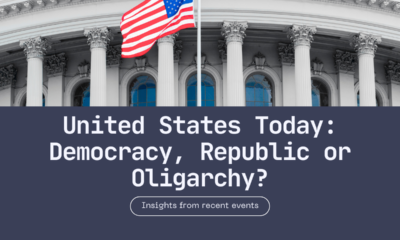Family
Idaho defends against abortion mandate
Yesterday morning the State of Idaho defended its position before the Supreme Court – against a radically pro-abortion administration. As has become fashionable, the Solicitor General badly misconstrued the rest of Idaho’s laws. She also miscounted the number of States that make exceptions for the life, but not the health, of the mother. Likewise, one Supreme Court Justice hinted at a State-level debate that is simply not taking place. Even without this misconstruction, the Liberal Bloc sought to paint a dire picture of life for women in Idaho that the law does not require. But for the first time, the Court – and the public beyond Idaho – heard of what CNAV construes as a demeaning – and dangerous – form of Kabuki Theater involving helicopter ambulance services. The remedy goes beyond vacating the preliminary injunction (now stayed) and dismissing the federal case. It will require a drastic change in medical education in America.
Summary of Idaho law, and the case
CNAV has discussed the particulars of US v. Idaho, case no. 1:22-cv-00329, before. (See docket pages in the District of Idaho Court, the Ninth Circuit, and the Supreme Court.) Briefly, thus: Title 18, Idaho Code, Section 622, says that abortion shall be a felony unless it is done:
- To prevent the death of the mother (in cases other than suicidal tendencies), and
- In cases of rape or incest.
And here is a point many have missed. Title 18, Idaho Code, Section 604 defines abortion as “use of any means” to terminate a pregnancy, knowing that such means will likely cause the death of the unborn child. But! Abortion does not include:
- Use of Intrauterine Devices (which are probably obsolete anyway) or oral contraceptives,
- Removing a stillborn,
- Removing a molar pregnancy or an ectopic pregnancy, or
- Treating a woman who was, but is no longer, pregnant.
CNAV discussed ectopic pregnancies before. Molar pregnancies are more dangerous. (Source: the Mayo Clinic.) In them, the placental tissue swells to form fluid-filled cavities called cysts. The unborn child cannot survive, and in complete molar pregnancy the out-of-control placental tissue absorbs it. Such a pregnancy cannot continue – which is likely why Idaho does not include its removal in the definition of abortion.
Judge Barry Lynn Winmill laid on a preliminary injunction. A Ninth Circuit panel stayed that – but then the full court, sitting en banc, lifted the stay. The Supreme Court stayed it again on January 5, 2024.
Essence of the government’s and State’s cases
The federal government, in its complaint, alleged that Idaho law would cruelly deny a woman emergency treatment in certain cases. One of the cases they named was ectopic pregnancy – which, by definition, does not constitute “abortion” under Idaho law! The others are:
- Toxemia of pregnancy, which the government calls by the obsolete terms pre-eclampsia and eclampsia. Eclampsia (from the Greek eklampto I shine forth) means toxemia with seizures. When toxemia becomes as severe as that, it could lead to kidney failure. Typically a doctor will “manage” this condition with magnesium sulfate, and try to nurse the mother along until her baby would be viable outside the womb. At that time, the treatment is to deliver the child, even if it’s premature. That’s not always possible – or so says the medical literature.
- Premature rupture of membranes (PROM). If the “waters” break before the baby can live outside the womb, the baby might be doomed.
- Placental abruption – in which the placenta tears itself free of the womb – or placenta praevia – in which the placenta has implanted directly athwart the cervical opening. Abruption especially can cause hemorrhage, and that hemorrhage could kill.
In its reply brief, Idaho reiterates that the handling of molar or ectopic pregnancies does not even constitute “abortion”. (Turn to pages 8 and 9.)
The other three cases would clearly fall under the life-of-the-mother exception. No less an authority than Idaho’s Supreme Court set forth this guidance.
The government goes overboard
But that wasn’t good enough for the Biden administration, or Judge Winmill; hence the injunction. That injunction should have no practical effect, because Idaho law is far more sensible than the federal government lets on. The problem, as the State sets forth, is:
The administration demands that EMTALA’s application turn not on objective clinical standards, U.S.Br.26 n.5; id. at 34 n.9, but on emergency-room doctors’ subjective “medical judgment.” E.g., Resp. in Opp’n to Appls. for a Stay at 35, Moyle v. United States, Nos. 23A469 and 23A470 (U.S. Nov. 30, 2023). The consequence is that EMTALA would not be limited to the truly life-threatening scenarios the government highlights, or even to abortion. If the administration’s position is accepted, doctors at Medicare-funded hospitals would become essentially unregulated, with their own medical judgment superseding all state laws regulating the practice of medicine. That is the exact opposite of 42 U.S.C. 1395’s premise that doctors continue to be governed by state law. And no clear statement suggests that is what Congress intended.
The real problem is that the Biden administration would see no abortion unperformed. They show that by advancing absurd theses that Idaho law, and the Idaho Supreme Court, contradict.
But now we see a complication. A campaign of fear-mongering must have started after the Dobbs decision (“the case that overturned Roe”) came down. Reportage in Roll Call, The Idaho Capital Sun, and Boise State Public Radio tell the effects of that campaign. After the stay of the injunction:
- 22 percent of Idaho’s practicing obstetricians have left the State.
- 55 percent of obstetricians specializing in high-risk pregnancies have left Idaho.
- Three labor and delivery departments have closed.
- Helicopter ambulance services airlifted six women out of State for emergency treatment in neighboring States. While the injunction remained, only one woman required such an airlift.
The federal government cited these airlifts as reasons to put that injunction back into effect. But no one (except CNAV) is asking who laid on that fear-mongering campaign that scared these doctors out. (Finding that out might require a private investigator.) Had those doctors stayed, those airlifts would not have been necessary. CNAV challenges any competent medical authority to dispute this.
Idaho and the federal government argue their cases
Oral argument in the consolidated applications for stay lasted for nearly two hours.
(Listen to it here.)
Joshua N. Turner, Chief Constitutional Litigation and Policy Officer for Idaho, argued the State’s case. Solicitor General Elizabeth B. Prelogar argued the federal case. Or perhaps she was really arguing her own case. Her voice betrays her as a radical feminist who – again – would see no abortion unperformed. She argued as “friend of the court” on the losing side of the Jackson Women’s Health Organization in Dobbs. Therefore she counts that case as a personal loss, and it surely rankles.
The three Liberal Justices (Ketanji Brown Jackson, Elena Kagan, and Sonia Sotomayor) spent their time relentlessly pressing the government’s points. They did so without regard to the actual text of Idaho’s laws, and made light of the Idaho Supreme Court’s opinion that the maternal life exceptions allowed a high-risk obstetrician absolute discretion in managing any of the “trouble cases” the government named. Sadly, Mr. Turner let those Justices rattle him, leading him to concede too much.
The Originalists – with consistent help from Moderate Justice Brett Kavanaugh and even Chief Justice Roberts – concentrated on how far the federal government would take their reading of the Emergency Medical Treatment And Labor Act (EMTALA) – and the Medicare Act. Justice Samuel A. Alito especially pounced on EMTALA’s mention of the life of the unborn child. How, he asked, does that square with an apparent abortion mandate? The Solicitor General could not give a satisfactory answer.
A mental-health exception?
Ms. Prelogar clearly fretted about the mention of a “mental health exception.” In an earlier brief she had written in a footnote:
Idaho badly errs in asserting that construing EMTALA according to its terms would turn emergency rooms into federal abortion enclaves by allowing pregnancy termination for mental health concerns.
In other words, she bitterly resented the very suggestion. Furthermore she asserted that EMTALA would not consider an abortion an appropriate emergency treatment for a pregnant woman’s mental-health crisis. Her reason: such a measure would do nothing to address the underlying cause of the crisis. But Mr. Turner pointed out that the American Psychiatric Association had said that abortion would be their recommendation in such a case. He cited this 2023 position paper decrying any restriction on abortion. Indeed the APA said in part:
Freedom to act to interrupt pregnancy must be considered a mental health imperative with major social and mental health implications.
Justice Sotomayor made another egregious misreading of current law for which she has made herself famous. She actually said some States were considering whether to have no exceptions, even for the mother’s life:
JUSTICE SOTOMAYOR: But what you’re saying is that no state in the nation – and there are some right now that don’t even have that as an exception to their anti-abortion laws. What you are saying is that there is no federal law on the book that prohibits any state from saying, even if a woman will die, you can’t perform an abortion.
MR. TURNER: Your Honor, I know of no state that does not include a life-saving exception. But, secondly, the government –
JUSTICE SOTOMAYOR: Some have been debating it at least, and if I find one – but your theory of this case leads to that conclusion.
Wrong! The Washington Times quoted the Kaiser Family Foundation as denying that any State has such a law. (Even the Alan Guttmacher Institute agreed with that.) Five States, including Idaho, speak of a mother’s life but not health. (Ms. Prelogar counted six States in addition to Idaho. Mr. Turner accepted that – but according to Kaiser, he shouldn’t have.) The NBC Interactive Abortion Law Map should dispel any confusion.
Ms. Prelogar, in defending the federal government’s prerogatives, cited one case that Justice Neil Gorsuch made her instantly regret citing:
GENERAL PRELOGAR: … I want to make sure to make clear that there are a long line of cases that stand for this principle, including cases that have addressed it directly like In re Debs –
JUSTICE GORSUCH: Oh, Debs.
GENERAL PRELOGAR: – Wyandot, so –
JUSTICE GORSUCH: Do you really want to rely on Debs, General? I mean, that wasn’t exactly our brightest moment.
GENERAL PRELOGAR: I do think, though, that it reflects the history and tradition of this nation in recognizing that it’s entirely appropriate for the United States to seek to protect its interests in this manner. And let me say, Justice Gorsuch –
JUSTICE GORSUCH: What do you –
GENERAL PRELOGAR: – this is a really important issue to the United States. It wasn’t pressed below. It wasn’t passed upon.
Zounds! A leftist citing Eugene V. Debs, the Railroad Striker, as a villain? When an Originalist has doubts about his case?
Conclusion
Ms. Prelogar does not appear to have gotten the required sympathy of the Moderate Bloc – not even from Amy Coney Barrett, who questioned both her and Mr. Turner very closely. She certainly did not have the sympathy of Justice Kavanaugh or Chief Justice John Roberts. Without that, the Liberal Bloc cannot prevail, and the Originalist Bloc will no doubt vote to vacate the injunction and remand the case. They could even remand with an instruction to dismiss the government’s case completely – though they might prefer to see the District Court test certain assertions at trial.
If this case were to go to trial before an impartial judge, Idaho would win easily. Idaho’s law is clear, and it does not impose any Draconian regime that would create a population of sick women.
But this case points out two weaknesses that the federal courts have. First, they depend on the lower-court record. Someone must investigate, for the record, who misinformed all those doctors to the point of scaring them out of Idaho. But perhaps the solution is for a Christian ministry to establish a medical academy in Idaho. Such an academy would train a cadre of doctors far more humble than the typical medical-school graduate tends to be.
Of greater concern is that the federal government is perpetrating a fraud on the federal courts. They have willfully misrepresented Idaho law as well as federal law. Therefore this is a case of “lawfare,” as damaging as the specious cases against Donald J. Trump.
Terry A. Hurlbut has been a student of politics, philosophy, and science for more than 35 years. He is a graduate of Yale College and has served as a physician-level laboratory administrator in a 250-bed community hospital. He also is a serious student of the Bible, is conversant in its two primary original languages, and has followed the creation-science movement closely since 1993.
-

 Executive4 days ago
Executive4 days agoSecret Service chief gets no solace
-

 Executive3 days ago
Executive3 days agoWaste of the Day: Louisville Taxpayers Pay Nearly $600,000 For Empty Building’s Maintenance, Security
-

 Guest Columns4 days ago
Guest Columns4 days agoFear Itself: Democrats’ Favorite Strategy Caused Their Current Chaos
-

 Executive3 days ago
Executive3 days agoWhere is Joe Biden – or Jill?
-

 Executive1 day ago
Executive1 day agoWaste of the Day: Throwback Thursday: Cities Used Crime Prevention Funds on Soccer Games, Paper Shredding
-

 Executive2 days ago
Executive2 days agoFacile and politically motivated suggestions
-

 Civilization5 days ago
Civilization5 days agoBuild Iron Dome in the United States To Prepare for Israel’s Worst Day
-

 Executive4 days ago
Executive4 days agoThe Emerging GOP Plan To Beat Kamala Harris












